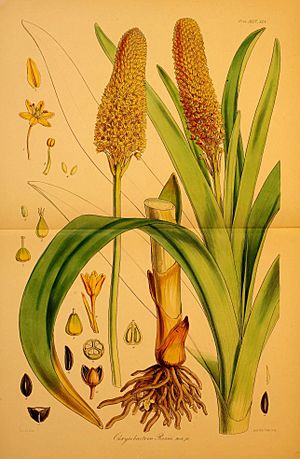Ross lily facts for kids
Quick facts for kids Ross lily |
|
|---|---|
 |
|
| Ross lily in flower with Australasian pipit | |
 |
|
| B. rossii as Chrysobactron rossii (Plate XLIV-XLV) | |
| Conservation status | |
|
Invalid status (NZ TCS)
|
|
| Scientific classification | |
| Synonyms | |
|
The Ross lily, also known by its scientific name Bulbinella rossii, is a special type of flowering plant. It belongs to the Bulbinella group of plants. This lily is one of the amazing "megaherbs" found in the subantarctic region. Megaherbs are very large plants that grow in these cold, windy places. The plant's scientific name, rossii, honors James Clark Ross. He was a British explorer who visited Campbell Island in December 1840.
Contents
What is the Ross Lily?
The Ross lily is a large perennial plant, which means it lives for many years. It can grow quite tall, up to 1 meter (about 3 feet) high. The base of the plant can be as wide as 40 millimeters (about 1.5 inches).
How the Ross Lily Looks
Its leaves are dark green and thick, like straps. They can be very long, from 0.6 to 1 meter (2 to 3 feet). They are also wide, about 15 to 60 millimeters (0.6 to 2.4 inches). The plant has a tall flower stalk called an inflorescence. This stalk can be up to 600 millimeters (2 feet) long.
Its Flowers and Seeds
The Ross lily has many golden yellow flowers packed closely together on its stalk. Each flower is about 10 to 14 millimeters (0.4 to 0.5 inches) wide. Sometimes, the flowers have an orange color mixed in. After flowering, the plant makes oval-shaped seed capsules. These capsules are about 10 millimeters (0.4 inches) long. Inside, they hold dark brown seeds that have narrow wings. The Ross lily blooms from October to January. Its seeds ripen and are ready from December to March.
Where Does the Ross Lily Live?
The Ross lily is endemic to New Zealand. This means it is found only in New Zealand's subantarctic Auckland and Campbell Islands. It grows commonly across these islands, from the sea level all the way up to the mountain tops.
Where It Likes to Grow
This plant grows well in places where the ground has been disturbed. It is also not a favorite food for browsing animals. Because of this, you can often find many Ross lilies growing near old places where people used to live. They can form thick groups in open herbfields and tussock grasslands.
Protecting the Ross Lily

The Ross lily is listed as "At Risk - Naturally Uncommon." This listing comes from the 2018 assessment using the New Zealand Threat Classification System. It means the plant is not in immediate danger, but it is naturally rare. This is because it only grows in a small area, on just a few islands.
See also
 In Spanish: Bulbinella rossii para niños
In Spanish: Bulbinella rossii para niños

